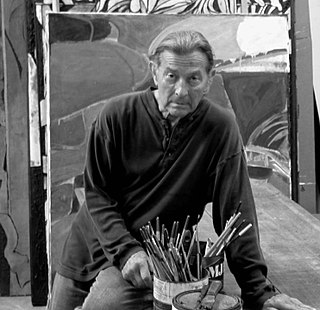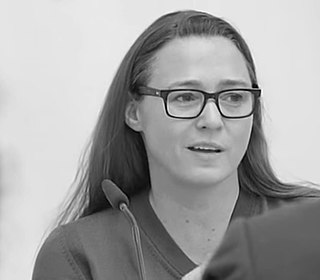Related Research Articles

Frank Owen Gehry,, FAIA is a Canadian-born American architect and designer. A number of his buildings, including his private residence in Santa Monica, California, have become world-renowned attractions.

Richard Diebenkorn was an American painter and printmaker. His early work is associated with abstract expressionism and the Bay Area Figurative Movement of the 1950s and 1960s. In the late 1960s he began his extensive series of geometric, lyrical abstract paintings. Known as the Ocean Park paintings, these paintings were instrumental to his achievement of worldwide acclaim.
Amelia Jones originally from Durham, North Carolina is an American art historian, art theorist, art critic, author, professor and curator. Her research specialisms include feminist art, body art, performance art, video art, identity politics, and New York Dada. Jones's earliest work established her as a feminist scholar and curator, including through a pioneering exhibition and publication concerning the art of Judy Chicago; later, she broadened her focus on other social activist topics including race, class and identity politics. Jones has contributed significantly to the study of art and performance as a teacher, researcher and activist.
Edward P. Roski Jr. is an American businessman and philanthropist. He is a billionaire, president of Majestic Realty, and appeared at #115 on the Forbes 400 in 2021, and owns more than 83 million square feet of real estate across the United States, as a business park developer through his company. Roski has served as its president since 1994, and previously as the executive vice-president and chief operating officer, from 1978 to 1994. He is a partial owner of the Los Angeles Kings, and the Los Angeles Lakers, and owns the Silverton Las Vegas. He is also a decorated veteran of the Vietnam War and art collector.

April Greiman is an American designer widely recognized as one of the first designers to embrace computer technology as a design tool. Greiman is also credited, along with early collaborator Jayme Odgers, with helping to import the European New Wave design style to the US during the late 70s and early 80s." According to design historian Steven Heller, “April Greiman was a bridge between the modern and postmodern, the analog and the digital.” “She is a pivotal proponent of the ‘new typography’ and new wave that defined late twentieth-century graphic design.” Her art combines her Swiss design training with West Coast postmodernism.
Alison Saar is a Los Angeles, California based sculptor, mixed-media, and installation artist. Her artwork focuses on the African diaspora and black female identity and is influenced by African, Caribbean, and Latin American folk art and spirituality. Saar is well known for "transforming found objects to reflect themes of cultural and social identity, history, and religion."
June Claire Wayne was an American painter, printmaker, tapestry innovator, educator, and activist. She founded Tamarind Lithography Workshop (1960–1970), a then California-based nonprofit print shop dedicated to lithography.
Erica Muhl is an American composer and conductor who is president of Berklee College of Music. She formerly served as dean of the USC Jimmy Iovine and Andre Young Academy and was previously dean of the University of Southern California Roski School of Art and Design. She received an Award in Music from the American Academy of Arts and Letters in 1999.

James Jarvaise was an American painter based in Southern California.
Mary Kelly is an American conceptual artist, feminist, educator, and writer.
Edgar Arceneaux is a contemporary artist who lives and works in Los Angeles, California. He is the co-founder of the Watts House Project, a non-profit neighborhood redevelopment organization in Watts.
Laura Geller is an American rabbi. She serves as the rabbi emerita of Temple Emanuel in Beverly Hills, California.

Laura Owens is an American painter, gallery owner and educator. She emerged in the late 1990s from the Los Angeles art scene. She is known for large-scale paintings that combine a variety of art historical references and painterly techniques. She lives and works in Los Angeles, California.
The Women's Caucus for Art (WCA), founded in 1972, is a non-profit organization based in New York City, which supports women artists, art historians, students, educators, and museum professionals. The WCA holds exhibitions and conferences to promote women artists and their works and recognizes the talents of artists through their annual Lifetime Achievement Award. Since 1975 it has been a United Nations-affiliated non-governmental organization (NGO), which has broadened its influence beyond the United States. Within the WCA are several special interest causes including the Women of Color caucus, Eco-Art Caucus, Jewish Women Artist Network, International Caucus and the Young Women's Caucus. The founding of the WCA is seen as a "great stride" in the feminist art movement.

Sharon Lockhart is an American artist whose work considers social subjects primarily through motion film and still photography, often engaging with communities to create work as part of long-term projects. She received her BFA from the San Francisco Art Institute in 1991 and her MFA from Art Center College of Design in 1993. She has been a Radcliffe fellow, a Guggenheim fellow, and a Rockefeller fellow. Her films and photographic work have been widely exhibited at international film festivals and in museums, cultural institutions, and galleries around the world. She was an associate professor at the University of Southern California's Roski School of Fine Arts, resigning from the school in August 2015 in response to the continued administrative turmoil at Roski to take a position at the California Institute for the Arts. Lockhart lives and works in Los Angeles, California.

Frances Stark is an interdisciplinary artist and writer, whose work centers on the use and meaning of language, and the translation of this process into the creative act. She often works with carbon paper to hand-trace letters, words, and sentences from classic works by Emily Dickinson, Goethe, Henry Miller, Samuel Beckett, and others to explore the voices and interior states of writers. She uses these hand-traced words, often in repetition, as visual motifs in drawings and mixed media works that reference a subject, mood, or another discipline such as music, architecture, or philosophy.
Phyllis Green is an artist whose practice involves sculpture, video and installation art. Based in Santa Monica, she has received a Guggenheim Fellowship, as well as grants from the City of Santa Monica, California Community Foundation, Durfee Foundation, Pollock-Krasner Foundation, California Arts Council, National Endowment for the Arts, Canada Council and British Columbia Cultural Fund. In 1996, she was among the first to be awarded a C.O.L.A. grant by the City of Los Angeles. In 2000, she was appointed to the Santa Monica Arts Commission, serving, as its chair from 2004 to 2006. She is married to the photographer Ave Pildas.

Nao Bustamante is a Chicana interdisciplinary artist, writer, and educator from the San Joaquin Valley in California. Her artistic practice encompasses performance art, sculpture, installation, and video and explores issues of ethnicity, class, gender, performativity, and the body.
Dianna Molzan is an American contemporary artist and painter based in Los Angeles. Thus far in her career, she is known for exploring the relationship between painting and sculpture through deconstruction and materialization of traditional painting materials and tools.
Edie Fake is an American artist, illustrator, author, and transgender activist. Fake is known for their comics/zines, gouache and ink paintings, and murals. Fake has an award winning comic-zine series about Gaylord Phoenix, a bird-like man that travels to different environments and has various lovers. He is currently based in Joshua Tree, California, after previously residing in Chicago and Los Angeles.
References
- ↑ Seed, John. "Ruth Weisberg: The Adventure of Living In Between". The Huffington Post. Retrieved 20 January 2017.
- ↑ Curtis, Cathy (December 23, 1988). "ART REVIEW : The Literal Universe of Ruth Weisberg". The Los Angeles Times. Retrieved 20 January 2017.
- ↑ Weisberg, Ruth; Hoffman, Lawrence A; Berman, Nancy M. (1997). Ruth Weisberg, the Scroll (exhibition catalog). New York: Hebrew Union College–Jewish Institute of Religion.
- ↑ Cheng, Scarlet (May 7, 2007). "Weisberg exhibition takes the long view". The Los Angeles Times. Retrieved 20 January 2017.
- ↑ "Ruth Weisberg". Jack Rutberg Fine Arts, Inc. Retrieved 20 January 2017.
- ↑ Korn, Paula (June 2, 1997). "Ruth Weisberg, an artist in Many Mediums, Exhibits Works Worldwide". News USC. Retrieved 20 January 2017.
- ↑ "Ruth Weisberg". Roski School of Art and Design. University of Southern California. Retrieved 20 January 2017.
- ↑ "Ruth Weisberg (American, born 1942)". Artnet. Retrieved 20 January 2017.
- ↑ "Collections: Weisberg, Ruth". Art Institute Chicago. Retrieved 20 January 2017.
- ↑ "Ruth Weisberg". Addington Gallery. Retrieved 20 January 2017.
- ↑ Levine, Debra. "USC's Ruth Weisberg honored with esteemed printmaking award". ArtsMeme. Retrieved 20 January 2017.
- ↑ "USC Hillel". Dr. Ruth Weinberg. University of Southern California. Retrieved 20 January 2017.
- ↑ "Distinguished Teaching of Art Awards". College Arts Association. Retrieved 20 January 2017.